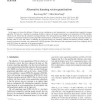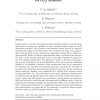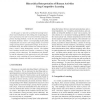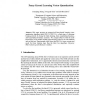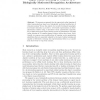PR
2006
14 years 11 days ago
2006
In this paper, we discuss the influence of feature vectors contributions at each learning time t on a sequential-type competitive learning algorithm. We then give a learning rate ...
KES
2006
Springer
14 years 12 days ago
2006
Springer
The issue of Automatic Relevance Determination (ARD) has attracted attention over the last decade for the sake of efficiency and accuracy of classifiers, and also to extract knowle...
DAGSTUHL
2009
14 years 1 months ago
2009
We introduce and discuss the application of statistical physics concepts in the context of on-line machine learning processes. The consideration of typical properties of very large...
ESANN
2006
14 years 1 months ago
2006
In this article, we extend a local prototype-based learning model by active learning, which gives the learner the capability to select training samples during the model adaptation...
ESANN
2006
14 years 1 months ago
2006
We apply Learning Vector Quantization (LVQ) in automated boar semen quality assessment. The classification of single boar sperm heads into healthy (normal) and non-normal ones is b...
ICONIP
2008
14 years 1 months ago
2008
We present a category learning vector quantization (cLVQ) approach for incremental and life-long learning of multiple visual categories where we focus on approaching the stability-...
ICPR
2002
IEEE
14 years 5 months ago
2002
IEEE
In this paper we describe a method of learning hierarchical representations for describing and recognizing gestures expressed as one and two arm movements using competitive learni...
ISNN
2004
Springer
14 years 5 months ago
2004
Springer
This paper presents an unsupervised fuzzy-kernel learning vector quantization algorithm called FKLVQ. FKLVQ is a batch type of clustering learning network by fusing the batch learn...
IDEAL
2005
Springer
14 years 6 months ago
2005
Springer
Novelty detection involves identifying novel patterns. They are not usually available during training. Even if they are, the data quantity imbalance leads to a low classification ...
DAGM
2005
Springer
14 years 6 months ago
2005
Springer
We present an approach for the supervised online learning of object representations based on a biologically motivated architecture of visual processing. We use the output of a rece...
